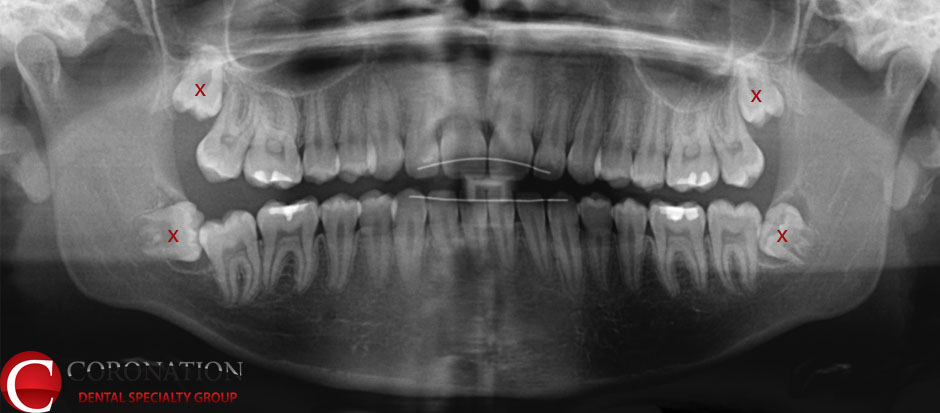Services > Oral and Maxillofacial Surgery > Removal of Impacted Wisdom Teeth
When a tooth is unable to fully enter the mouth, it is said to be “impacted”. Wisdom teeth, also known as third molars, are the last teeth to develop in the mouth, and are the most commonly impacted teeth. Studies have shown that removing impacted wisdom teeth earlier in life results in fewer complications and easier healing.
Wisdom teeth typically erupt between 16-20 years of age. While some may erupt properly through the gum or bone, many people have insufficient space for them to come completely through. In these cases, a flap of gum tissue known as an operculum covers the tooth, making it difficult to clean properly. If food or bacteria collects in these areas, a chronic inflammatory reaction can occur, and sometimes infection as well. Many people will develop swelling of the gum flap, known as pericoronitis, which can be very painful, and make it difficult to chew.

The wisdom teeth are marked with an “x”. The upper wisdom teeth are vertically impacted, while the lower wisdom teeth are horizontally impacted.
Many lower wisdom teeth lie at the wrong angle, and point into the back of the adjacent tooth. This increases the risk of damage to both teeth in the form of cavities, and also the formation of deep gum pockets that cannot be cleaned. Upper wisdom teeth can sometimes erupt through the gum tissue, but be pointed toward the cheek (sideways, instead of down). These can sometimes be the most difficult teeth to clean given how high and how far back they are in the jaw.
In rare cases, cysts or tumours may form around impacted wisdom teeth. These potentially destructive pathologic lesions can cause damage to adjacent teeth, bone, and other anatomic structures. Pathologic fracture of the jaw is a risk when these lesions enlarge and eat away at the supporting bone. If any of these lesions are seen on an x-ray, their removal becomes urgent.

The impacted wisdom tooth on the lower left has a large cyst behind it (arrows). The lower edge of the cyst extends near the bottom of the jaw, leaving only a sliver of healthy bone. There is a high risk of a broken jaw in this area.
In some cases, wisdom teeth are removed to facilitate braces, or orthodontics. If there is insufficient space in the jaw, your orthodontist may suggest removing the wisdom teeth to decrease pressure, and to lessen the risk of crowding or shifting of adjacent teeth.
Some people require removal of their wisdom teeth before starting orthodontic treatment, others need them removed during treatment, while some can wait until braces are finished. Each situation is different, and depends on factors such as the patient’s age, room available in the jaw, whether any additional teeth need to be removed, and whether the wisdom teeth are causing other problems.
What to do After Wisdom Teeth Have Been Removed
Most people have many questions after their wisdom teeth have been removed. We have some general instructions for care after wisdom teeth have been removed.
We will work closely with your dentist or orthodontist if they have recommended that you need to have teeth removed.
We will be happy to set up a consultation appointment with you. A dental specialist will speak with you regarding the position of your teeth, whether they need to be removed, and any procedures that will be involved. Please contact us, and we will be happy to speak with you further.